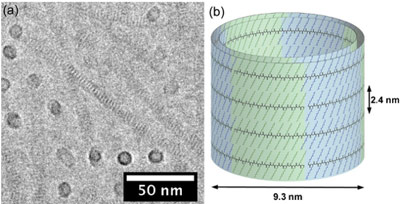
(b) Molecular model showing how the peptoid chains act as molecular tile units that form crystalline, brick-like lattices that roll into nanotubes, and expose both hydrophobic and hydrophilic groups to water.
Scientific Achievement
Electron micrographs of amphiphilic peptoids in water reveal crystalline nanotubes with exposed hydrophobic groups.
Significance and Impact
The 2.4 nm stripe pattern in the electron micrograph rules out the possibility of micelle formation, establishing a new principle of supramolecular assembly.
Research Details
- Peptoid blocks are chemically dissimilar, but are congruent in size and shape, enabling them to pack into regular lattices.
- Hollow nanotubes of uniform diameter are formed, without a central hydrophobic core in aqueous solution, without chirality, a hydrogen bond network, electrostatic or pi-pi interactions.

